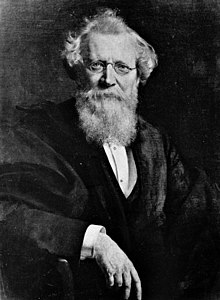August Wilhelm von Hofmann | |
|---|---|
 | |
| Born | 8 April 1818 Giessen, Germany |
| Died | 5 May 1892 (aged 74) Berlin, Germany |
| Alma mater | University of Giessen |
| Known for | |
| Spouses |
|
| Awards |
|
| Scientific career | |
| Fields | Organic chemistry |
| Institutions | |
| Doctoral advisor | Justus von Liebig |
| Doctoral students | |
August Wilhelm von Hofmann (8 April 1818 – 5 May 1892[2]) was a German chemist who made considerable contributions to organic chemistry. His research on aniline helped lay the basis of the aniline-dye industry, and his research on coal tar laid the groundwork for his student Charles Mansfield's practical methods for extracting benzene and toluene and converting them into nitro compounds and amines. Hofmann's discoveries include formaldehyde, hydrazobenzene, the isonitriles, and allyl alcohol.[3] He prepared three ethylamines and tetraethylammonium compounds and established their structural relationship to ammonia.
After studying under Justus von Liebig at the University of Giessen, Hofmann became the first director of the Royal College of Chemistry, now part of Imperial College London, in 1845. In 1865 he returned to Germany to accept a position at the University of Berlin as a teacher and researcher. After his return he co-founded the German Chemical Society (Deutsche Chemische Gesellschaft) (1867).[3] In both London and Berlin, Hofmann recreated the style of laboratory instruction established by Liebig at Giessen, fostering a school of chemistry focused on experimental organic chemistry and its industrial applications.[4]
Hofmann received several significant awards in the field of chemistry, including the Royal Medal (1854), the Copley Medal (1875) and the Albert Medal (1881). He was elected as a member of the American Philosophical Society in 1862.[5] He was ennobled on his seventieth birthday.[4] His name is associated with the Hofmann voltameter, the Hofmann rearrangement, the Hofmann–Martius rearrangement, Hofmann elimination, and the Hofmann–Löffler reaction.
- ^ Volhard, Jacob; Fischer, Emil (1902). August Wilhelm von Hofmann: Ein Lebensbild. Berlin.
{{cite book}}: CS1 maint: location missing publisher (link) - ^ Grete Ronge (1972), "Hofmann, August Wilhelm von (preußischer Adel 1888)", Neue Deutsche Biographie (in German), vol. 9, Berlin: Duncker & Humblot, pp. 446–450; (full text online)
- ^ a b August Wilhelm von Hofmann at the Encyclopædia Britannica
- ^ a b Brock, W. H. (2008). "Hofmann, August Wilhelm Von". Encyclopedia.com. Retrieved 7 September 2023.
- ^ "APS Member History". search.amphilsoc.org. Retrieved 20 April 2021.